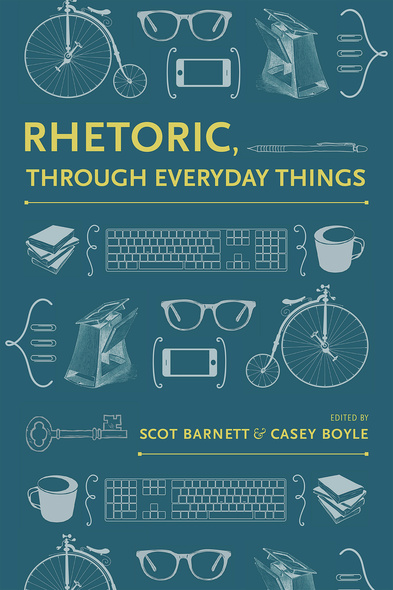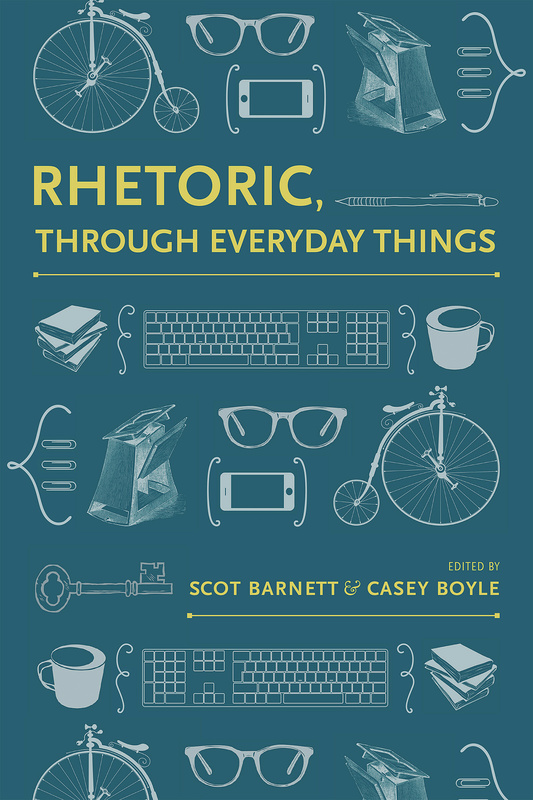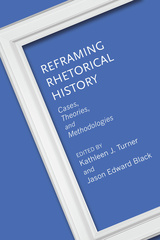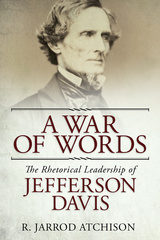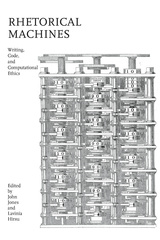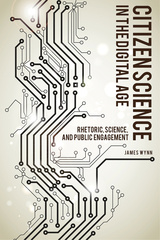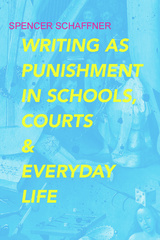Rhetoric, Through Everyday Things
University of Alabama Press
A fascinating addition to rhetoric scholarship, Rhetoric, Through Everyday Things expands the scope of rhetorical situations beyond the familiar humanist triad of speaker-audience-purpose to an inclusive study of inanimate objects.
The fifteen essays in Rhetoric, Through Everyday Things persuasively overturn the stubborn assumption that objects are passive tools in the hands of objective human agents. Rhetoric has proved that forms of communication such as digital images, advertising, and political satires do much more than simply lie dormant, and Rhetoric, Through Everyday Things shows that objects themselves also move, circulate, and produce opportunities for new rhetorical publics and new rhetorical actions. Objects are not simply inert tools but are themselves vibrant agents of measurable power.
Organizing the work of leading and emerging rhetoric scholars into four broad categories, the collection explores the role of objects in rhetorical theory, histories of rhetoric, visual rhetoric, literacy studies, rhetoric of science and technology, computers and writing, and composition theory and pedagogy. A rich variety of case studies about objects such as women’s bicycles in the nineteenth century, the QWERTY keyboard, and little free libraries ground this study in fascinating, real-life examples and build on human-centered approaches to rhetoric to consider how material elements—human and nonhuman alike—interact persuasively in rhetorical situations.
Taken together, Rhetoric, Through Everyday Things argues that the field of rhetoric’s recent attention to material objects should go further than simply open a new line of inquiry. To maximize the interdisciplinary turn to things, rhetoricians must seize the opportunity to reimagine and perhaps resolve rhetoric’s historically problematic relationship to physical reality and ontology. By tapping the rich resource of inanimate agents such as "fish, political posters, plants, and dragonflies,” rhetoricians can more fully grasp the rhetorical implications at stake in such issues.
The fifteen essays in Rhetoric, Through Everyday Things persuasively overturn the stubborn assumption that objects are passive tools in the hands of objective human agents. Rhetoric has proved that forms of communication such as digital images, advertising, and political satires do much more than simply lie dormant, and Rhetoric, Through Everyday Things shows that objects themselves also move, circulate, and produce opportunities for new rhetorical publics and new rhetorical actions. Objects are not simply inert tools but are themselves vibrant agents of measurable power.
Organizing the work of leading and emerging rhetoric scholars into four broad categories, the collection explores the role of objects in rhetorical theory, histories of rhetoric, visual rhetoric, literacy studies, rhetoric of science and technology, computers and writing, and composition theory and pedagogy. A rich variety of case studies about objects such as women’s bicycles in the nineteenth century, the QWERTY keyboard, and little free libraries ground this study in fascinating, real-life examples and build on human-centered approaches to rhetoric to consider how material elements—human and nonhuman alike—interact persuasively in rhetorical situations.
Taken together, Rhetoric, Through Everyday Things argues that the field of rhetoric’s recent attention to material objects should go further than simply open a new line of inquiry. To maximize the interdisciplinary turn to things, rhetoricians must seize the opportunity to reimagine and perhaps resolve rhetoric’s historically problematic relationship to physical reality and ontology. By tapping the rich resource of inanimate agents such as "fish, political posters, plants, and dragonflies,” rhetoricians can more fully grasp the rhetorical implications at stake in such issues.
With this volume, Barnett and Boyle go beyond the reach of the speaker-audience-purpose model of human communication to include material objects. The book comprises four parts: 'The New Ontology of Persuasion,' 'Writing Things,' 'Seeing Things,' and 'Assembling Things.' The contributors—an impressive group of scholars ranging from experts to doctoral candidates—offer essays that explore objects as vibrant agents of persuasion and not just passive nonverbal tools. In a particularly intriguing chapter titled 'The Things They Left Behind: Toward an Object-Oriented History of Composition,' Kevin Rutherford and Jason Palmeri encourage the reader to engage in an empathetic dialogue with nonhuman historical objects: for example, history might be read differently if one examined the writing desks of important figures. This book has deep implications for the present materialist turn in the humanities. Unique for its ontological synthesis of rhetorical theory and nonverbal communication, this volume would be useful as a companion reader to a range of courses in rhetoric—from the basic course to advanced seminars—and it would be excellent complementary reading for courses in nonverbal communication. Summing Up: Highly recommended.’
—CHOICE
Many scholars are writing and thinking about rhetoric’s materiality, and this collection’s emphasis on ontology is one of the most popular ways of engaging the subject. The essays in Rhetoric, Through Everyday Things address a notoriously difficult set of theoretical problems in a way that will be approachable for advanced undergraduate and graduate students as well as more advanced scholars in rhetoric. I can imagine it being of great interest to scholars in both communication and English departments.’
—Greg Dickinson, coeditor of Places of Public Memory: The Rhetoric of Museums and Memorials and author of Suburban Dreams: Imagining and Building the Good Life
'This volume is an important and capacious contribution to the arrival of 'thing theory' in rhetorical studies. The tensions across chapters will make this a lively text for discussion. It will be taught and cited for the coming years, and I commend the editors for assembling such a thorough collection of essays.'
—Debra Hawhee, author of Moving Bodies: Kenneth Burke at the Edges of Language and Rhetoric in Tooth and Claw: Animals, Language, Sensation
Scot Barnett is an assistant professor of English at Indiana University.
Casey Boyle is an assistant professor of rhetoric and writing at the University of Texas at Austin.
Casey Boyle is an assistant professor of rhetoric and writing at the University of Texas at Austin.

